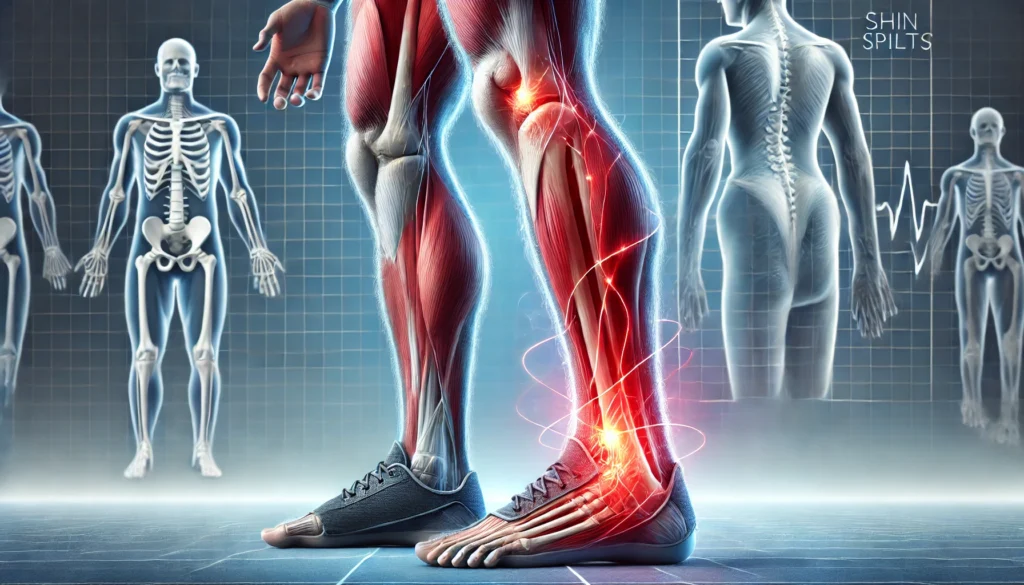
If you’re a runner or engage in high-impact activities, you’ve likely encountered or heard of shin splints. This common overuse injury can be frustrating and painful, but with proper understanding and care, it can be managed effectively. Let’s dive into what shin splints are, how to treat them, and most importantly, how to prevent them.
What Are Shin Splints?
Shin splints, medically known as medial tibial stress syndrome, are an inflammation of the muscles, tendons, and bone tissue around the tibia (shinbone)1. This condition typically occurs when the body is subjected to repetitive stress, especially in activities like running or dancing5.
Symptoms
The primary symptom of shin splints is pain along the inner edge of the shinbone. This pain may:
- Start as a dull ache before, during, or after activity
- Become sharp or throbbing as the condition worsens
- Be tender to the touch along the shinbone1
Causes and Risk Factors
Several factors can contribute to the development of shin splints:
- Sudden increases in exercise intensity or duration
- Running on hard or inclined surfaces
- Inadequate footwear
- Flat feet or high arches
- Muscle imbalances in the lower leg15
Treatment
If you suspect you have shin splints, here are some steps you can take:
- Rest: Take a break from the activity causing pain for 1-2 weeks3.
- Ice: Apply ice to reduce inflammation and swelling2.
- Pain relief: Use over-the-counter anti-inflammatory medications like ibuprofen if needed2.
- Compression: Consider using compression socks or kinesiology tape2.
- Gradual return: When pain subsides, slowly reintroduce your activity, starting at a lower intensity3.
Prevention
Preventing shin splints is crucial for maintaining an active lifestyle. Here are some strategies:
- Proper footwear: Wear shoes that fit well and provide adequate support. Replace running shoes every 300-400 miles17.
- Gradual progression: Increase your exercise intensity and duration slowly over time5.
- Cross-training: Incorporate low-impact activities like swimming or cycling into your routine15.
- Stretching and strengthening: Focus on exercises that target your lower legs, ankles, hips, and core7.
- Surface consideration: When possible, run on softer surfaces like an indoor track or treadmill5.
- Proper technique: Ensure you’re using correct form when running or engaging in other high-impact activities5.
When to See a Doctor
While shin splints often improve with self-care, consult a healthcare professional if:
- Pain persists or worsens despite rest and home treatment
- You suspect a stress fracture
- The pain is severe or accompanied by swelling6
Remember, listening to your body and giving it adequate time to recover is crucial in managing and preventing shin splints. By incorporating these tips into your fitness routine, you can continue to enjoy your favorite activities while minimizing the risk of this common injury.
Disclaimer: This content is for informational purposes only and is not intended to substitute professional medical advice, diagnosis, or treatment. Always seek the advice of your physician or qualified health provider with any questions you may have regarding a medical condition.
Citations:
- https://www.upmc.com/services/orthopaedics/conditions/shin-splints
- https://nyulangone.org/news/runners-world-understanding-shin-splints-how-best-treat-them
- https://www.mountsinai.org/health-library/selfcare-instructions/shin-splints-self-care
- https://www.orthoatlanta.com/media/5-easy-stretches-to-prevent-shin-splints
- https://www.orlandohealth.com/content-hub/why-runners-get-shin-splints-and-how-to-avoid-them/
- https://www.nhs.uk/conditions/shin-splints/
- https://www.webmd.com/fitness-exercise/shin-splints
- https://www.choosept.com/health-tips/8-tips-prevent-shin-splints
- https://www.performanceorthonj.com/blog/how-runners-can-avoid-shin-splints
- https://orthoinfo.aaos.org/en/diseases–conditions/shin-splints/
- https://www.bayfronthealth.com/content-hub/7-ways-to-avoid-shin-splints/
- https://www.onepeloton.com/blog/how-to-avoid-shin-splints/
- https://www.hopkinsmedicine.org/health/conditions-and-diseases/shin-splints
- https://www.massgeneralbrigham.org/en/about/newsroom/articles/shin-splints-prevention-treatment
- https://www.youtube.com/watch?v=Y-omKMFSjCI
- https://medlineplus.gov/ency/patientinstructions/000654.htm
- https://www.aurorahealthcare.org/services/sports-health/conditions/shin-splints
- https://www.runnersworld.com/health-injuries/a20857494/how-to-treat-shin-splints/
- https://www.healthdirect.gov.au/shin-splints
- https://www.mayoclinic.org/diseases-conditions/shin-splints/symptoms-causes/syc-20354105
